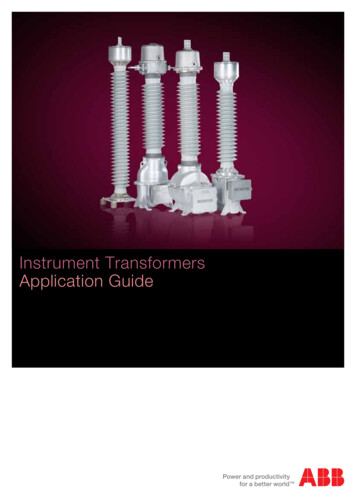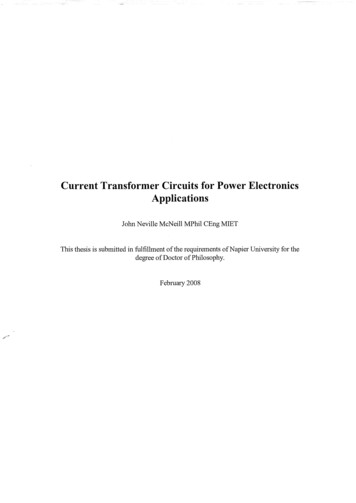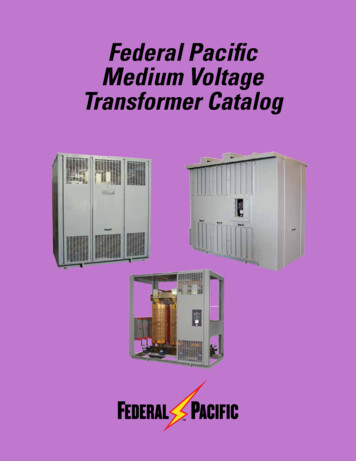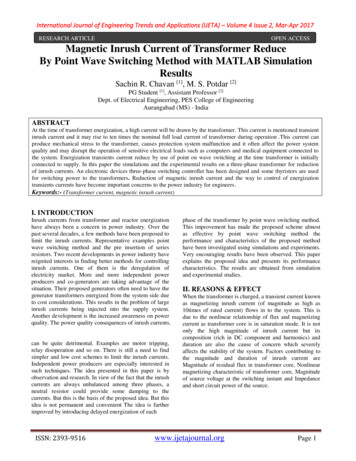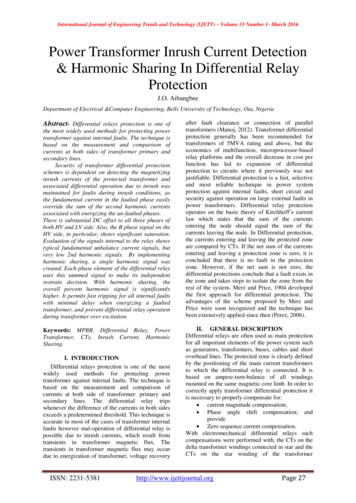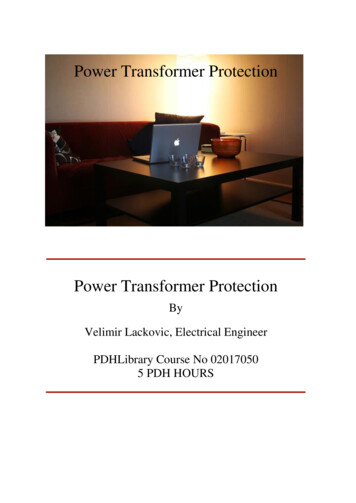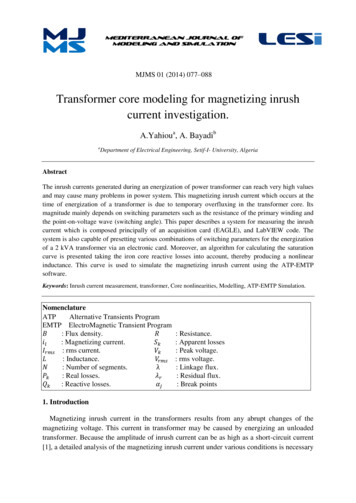
Transcription
Mediterranean Journal ofModeling and SimulationMJMS 01 (2014) 077–088Transformer core modeling for magnetizing inrushcurrent investigation.A.Yahioua, A. BayadibaDepartment of Electrical Engineering, Setif-I- University, AlgeriaAbstractThe inrush currents generated during an energization of power transformer can reach very high valuesand may cause many problems in power system. This magnetizing inrush current which occurs at thetime of energization of a transformer is due to temporary overfluxing in the transformer core. Itsmagnitude mainly depends on switching parameters such as the resistance of the primary winding andthe point-on-voltage wave (switching angle). This paper describes a system for measuring the inrushcurrent which is composed principally of an acquisition card (EAGLE), and LabVIEW code. Thesystem is also capable of presetting various combinations of switching parameters for the energizationof a 2 kVA transformer via an electronic card. Moreover, an algorithm for calculating the saturationcurve is presented taking the iron core reactive losses into account, thereby producing a nonlinearinductance. This curve is used to simulate the magnetizing inrush current using the ATP-EMTPsoftware.Keywords: Inrush current measurement, transformer, Core nonlinearities, Modelling, ATP-EMTP Simulation.NomenclatureATPAlternative Transients ProgramEMTP ElectroMagnetic Transient Program: Flux density.: Magnetizing current.: rms current.: Inductance.: Number of segments.: Real losses.: Reactive losses.: Resistance.: Apparent losses: Peak voltage.: rms voltage.: Linkage flux.: Residual flux.: Break points1. IntroductionMagnetizing inrush current in the transformers results from any abrupt changes of themagnetizing voltage. This current in transformer may be caused by energizing an unloadedtransformer. Because the amplitude of inrush current can be as high as a short-circuit current[1], a detailed analysis of the magnetizing inrush current under various conditions is necessary
A.Yahiou et al. / MJMS 01 (2014) 077–088for the concerns of a protective system for the transformers. In this regard, some numericaland analytical methods have been proposed in the literature.Bertagnolli proposes a relatively simple equation based on a sustained exponential decay ofthe inrush current [2]. The analytical formula proposed by Specht is somewhat more accurateas the decay of the dc component of the flux (BR) is considered only during saturation(B BS) [3]. Holcomb proposes an improved analytical equation [4]. We find an improveddesign method for a novel transformer inrush current reduction scheme in [5]. The usedscheme energizes each phase of a transformer in sequence and uses a neutral resistor to limitthe inrush current. A transformer model for inrush current simulation based on separatemagnetic and electric equivalent circuits is discussed in [6].Some methods have been used to convert thecurve to (flux ― peak current)curve [7, 8].In this paper, first, a method to calculate the saturation curve is presented taking the ironcore reactive losses into account, thereby producing a nonlinear inductance. It is also shownthat the method is applicable for modelling nonlinearities of power transformers. Then, thesystem for measuring the inrush current is described. The system is also capable of presettingtwo factors affecting the magnetizing inrush current (resistance and the point- on-voltagewave at the instant of energization). Finally a one-phase transformer is simulated in ATPEMTP software, the simulation results are compared with the experimental results.2. Flux and inrush currentAs seen from the Fig. 1 (this figure shows the generation of inrush current in atransformer), exceeding flux from the knee point, results in large magnetizing current that insome circumstances can be ten times of the rated current in a transformer.λMagnetisation curveλλrFlux𝑡𝑙𝑙InrushcurrentMagnetising current𝑡Figure 1. Flux VS magnetzing current.3. Iron core modellingUnder open circuit test configuration, the equivalent circuit of a power transformer can bereduced to a resistancein parallel with an inductance[9], as shown in Fig. 2.The main nonlinear element in the transformer’s model is a ferromagnetic inductance .The inductanceis defined by gradientin any point of nonlinear magnetizingcurve.The piecewise linearized curve is shown in Fig. 3.For computation, the method requires only () curves and the no-load lossesat fundamental frequency. Then, calculates the reactive powerusing:78
A.Yahiou et al. / MJMS 01 (2014) 077–088(1)Where:: Apparent power of the segment .it(t)ir(t)v(t)il(t)RmLmLinkage flux λFigure 2. Transformer model for open circuit test.λ3XmNλ2Xm2λ1Xm1Xm1Magnetizing current il-λ1Xm2-λ2XmN-λ3Figure 3. Nonlinear saturation curve.3.1. Computation of magnetizing curveLet us assume that the reactive no-load lossesfunction of the applied voltageare available as a, as shown in Fig. 4.Figure 4.Characteristic.Because of the symmetry of thecharacteristic with respect to the origin, it issufficient to observe quart of the cycle, in other word for an angle(Fig. 5).In general,can be found for eachthrough the nonlinearcharacteristic,either graphically as indicated by the dotted lines in Fig. 8. This will give us the curveover quart of a cycle, from which the no-load reactive losses are found:79
A.Yahiou et al. / MJMS 01 (2014) 077–088(2)Let us address the reverse problem, i.e., constructing thereactive losses.Forthe reactanceis equal:from the given no-load(3)The current of the first segment is:(4)Forvoltage, we must use the reactive power definition of equation (2), with the applied.(5)Withis the peak voltage.(6)The pointsin equation (5) are known using:(7)The only unknown factor in equation (5) is the slopeof last segment during the currentcalculation of the same slope.Equation (5) can be rewritten as follows (simplified form):(8)80
A.Yahiou et al. / MJMS 01 (2014) 077–088vv( π/2(b)(a)The currentFigure 5. Calculation of the nonlinear inductance.Curve, (b) Output current, (c) Sinusoidal input voltage signal.is obtained by:(9)The above mentioned procedure stages for calculating the saturation curve are summarizedin the following flow chart (Fig. 6).81
A.Yahiou et al. / MJMS 01 (2014) 077–088BeginInput the values of 𝐕𝐞𝐟𝐟, 𝐈𝐞𝐟𝐟 and 𝐏𝐤 .N: size of vector 𝐕𝐞𝐟𝐟Calculate𝐢𝐥𝟏 And 𝐗 𝟏 .Determine𝐐𝐤 𝟏 .𝜶 𝒋 0NoIf i iYesCalculate 𝛂𝐢𝐣i 2 , j 1Calculate𝒚𝒌No𝒄𝒋 𝟎If i jYesCalculate : 𝒄 𝒋 𝟖 ,. ,𝑿 𝟗 .Saturation curve ( )EndFigure 6. Flow chart to compute.No load losses and rms current at 50 Hz were measured for different voltage levels areshown in Table I.According to Faraday’s law and in case of a sinusoidal applied voltage, it can be written[10].(10)The computed points (including core losses) using our approach are shown in table II. Theresults obtained using the method described in [11] are included for comparison purposes.The obtainedcharacteristic is shown in Fig. 7.It is noted that there is a superposition up to the point (127.0708, 0.6874) because thetransformer has an internal capacitance between the coils and between the winding and theground. Therefore there is a small current in the magnetizing branch of the equivalentcircuit.As can be seen, for the same value of , the current calculated using our approach has avalue higher than that calculated by [11], which enables us to predict more exact peak inrushcurrent in the simulation (Fig 13).82
A.Yahiou et al. / MJMS 01 (2014) 077–088Table 1.Curve point and Corresponding Active Power 31.367.2107.9152.7194.1220225.6229.300Table 2. Calculated Points 99031.01561.03221.4With Active Losses[11]With Reactive LossesLinkage Flux (V.s)1.210.80.60.40.200200400600Magnetizing Current (mA)800Figure 7. Magnetization (saturation) curve831000𝑙 .
A.Yahiou et al. / MJMS 01 (2014) 077–0884. Measurement setup of inrush currentOne power transformer (2 kVA) has been used for laboratory investigations. Thistransformer is manufactured by unilab laboratory (Italy). It is unloaded; the high voltage sideis connected to voltage supply. The laboratory arrangement with the voltage and currentmeasurement points is shown in Fig. 8. A photo is shown in Fig. 9.The data acquisition system has been used to record voltages and currents at the highvoltage side. A total of fifteen analogue input channels with simultaneous sampling areavailable. The input voltage can be selected among 10 V. The graphical user interface inLabVIEW is shown in Fig. 10.Unloade 2kVA, rdviAcquisition cardFigure 8. Measurement setup scheme.Figure 9. Laboratory setup photo.Figure 10. LabVIEW acquisition interface.Figure 11. LabVIEW acquisition diagram.5. Measured and simulated inrush current comparisonWhen a transformer is energized under no load or lightly loaded conditions, inrush currentmay flow in the primary circuit.In order to investigate the effects of some parameters of transformer or network on theinrush current, a single-phase transformer (2 kVA, 220/25 V, 9.1/80 A) is selected. Theequivalent circuit can be shown in Fig. 12 where , ,,andare equivalentresistance, leakage inductance of transformer, core losses resistance, magnetizing inductanceand source resistance respectively.Table III presents the parameters obtained according to standards short and open circuittests.This circuit is simulated using ATP-EMTP software. The BCTRAN module and externalnonlinear inductance type 93 representing the saturation curve have been used in thissimulation.84
A.Yahiou et al. / MJMS 01 (2014) 077–088Figure 12. Simulation model of transformer.Table 3. Transformer parameters.ParameterValue3.488.72847.15.1. Simulation by Using the both Saturation CurvesFig. 13 shows the peak of the measured and simulated inrush current; in the simulation oneintroduces the both curves in the magnetizing branch, obtained by the method based on theactive losses [11], and the method presented in this paper.40Measurement.Simulation Using the calculated CurveAccording to [11].Simulation Using the Calculated CurveAccording to présented Method.35Inrush Current 50.1150.13Time (s)Figure 13. Inrush current comparison.As shown in above figure; it is clear that the peak of the inrush current obtained with usingthe calculated curve by taking the iron core reactive losses into account, near to the measuredpeak. So we have a good prediction of the peak Inrush current in the following application.5.2. Effects of source resistance (RS)In this case, the switching angle (θ) is considered 0 (primary voltage is 0 V). The effects ofseries resistance have been considered by increasing .The effect of source resistance on the amplitude of inrush current is presented in Fig. 14.85
A.Yahiou et al. / MJMS 01 (2014) 077–0883037.535Simulated Inrush CurrentMeasured Inrush CurrentPrimary Voltage/100Supply Voltage/100252015105201510500-5Simulatd Inrush CurrentMeasured Inrush CurrentPrimary Voltage/100Supply Voltage/10025Voltage/100 (V) , Current (A)Voltage/100 (V) , Current (A)300.06a)Time (s)0.09-50.120,06.0,09Time (s)b)0,12.25Simulated Inrush CurrentMeasured Inrush CurrentPrimary Voltage/100Supply Voltage/100Voltage/100 (V) , Current (A)2017.5151050-50.06Time (s)0.090.12c)Figure 14. Measured and simulated inrush current for different values of RS.As can be seen from Fig 13, increasing source resistance will decrease the amplitude ofinrush current. Moreover, it causes faster decay in the amplitude of inrush current. Therefore,it can be said that transformers located closer to the generating plants display higher amountof inrush currents lasting much longer than transformer installed electrically away fromgenerator.5.3. Effect of the switching angle (Point- On-Voltage)In this section, the effect of the closing moment of circuit breaker or the point on thevoltage wave where the circuit breaker is closed has been investigated. In this case the seriesresistance is ignored.The first result was already presented in Fig. 14 a. Fig. 15 presents the first measured andsimulated five peaks of inrush current when the applied voltage is equal to 195 V and then to182 V (i.e. for closing times t 0,0492s and t 0,0501s respectively).It is noted that the highest inrush current amplitude took place when the value of theprimary voltage of the transformer is equal to zero. Moreover, the increase in the angle on thevoltage wave makes decrease of its amplitude. The energization of the power transformerswith a random circuit breaker closing can generate very important amplitude of inrushcurrent. So, it is necessary to control the circuit breaker to choose the optimal moment as afunction of the network voltage which allows opening or closing the circuit breaker.86
A.Yahiou et al. / MJMS 01 (2014) 077–08830Voltage/100 (V) , Current (A)25(0.0492, 195)2017.5151050-530Measured Inrush CurrentPrimary Voltage/100Supply Voltage/100Simulated Inrush Current25Voltage/100 (V) , Current (A)Measured Inrush CurrentPrimary Voltage/100Supply Voltage/100Simulated Inrush Current201 6.5(0.0501, 182)10500.060.090.12Time (s)-50.060.09Time (s)0.12(a) t 0,0492s(b) t 0,0501sFigure 15. Measured and simulated inrush current for different Point- On-Voltage.6. ConclusionIn This paper a system for measuring the inrush current which is composed mainly of anacquisition card and LabVIEW code is described. The system is capable of presetting variouscombinations of switching parameters for the energization of a 2 kVA transformer via anelectronic card. Moreover, an algorithm for calculating the saturation curve is presentedtaking the iron core reactive losses into account, thereby producing a nonlinear inductance.This curve is used to simulate the magnetizing inrush current using the ATP-EMTP software.The results show that increasing switching angle (the point on the voltage wave) or sourceresistance will decrease the amplitude of inrush current. Therefore, the transformers locatedcloser to the generating plants display higher amount of inrush currents lasting much longerthan transformer installed electrically away from generator.Moreover, it can be concluded that, for reducing inrush current, an appropriate switchingangle by considering residual flux, must be taken into account.7. References[1] Steurer M., Fröhlich K, "The Impact of Inrush Currents on the Mechanical Stress of HighVoltage Power Transformer Coils", IEEE Trans. on Power Delivery, Vol.17, No.1, Jan2002, pp. 155-160.[2] G. Bertagnolli, Short-Circuit Duty of Power Transformers, Second Revised Edition. ABB,1996[3] T. R. Specht, "Transformer magnetizing inrush current" , AIEE Trans, Vol. 70, 1951, pp.323-328[4] J. F. Holcomb, "Distribution transformer magnetizing inrush current", Transactions of theAmerican Institute of Electrical Engineers, Part III (Power Apparatus and Systems), Vol.80, No. 57, Dec. 1961, pp. 697-702[5] Sami G. Abdulsalam, and Wilsun X " Analytical Study of Transformer Inrush CurrentTransients and Its Applications" , IPST’05 - International Conference on Power SystemsTransients, Montreal, Canada June 19-23, 2005, No. 140[6] N. Chiesa, B. A. Mork, and H. K. Høidalen, " Transformer Model for Inrush CurrentCalculations: Simulations, Measurements and Sensitivity Analysis", IEEE Trans onPower Delivery, Vol. 25, No. 4, Oct 2010, pp. 2599-260887
A.Yahiou et al. / MJMS 01 (2014) 077–088[7] A. Tokic, I. Uglesic, et F. Jakl, " An algorithm for calculations of low frequencytransformer transients", IPST’03 - International Conference on Power SystemsTransients, , New Orleans, Louisiana, USA, Sep. 2003 No. 9a-2[8] W.Wiechowski, B.Bak-Jensen, C. Leth Bak, J. Lykkegaard " Harmonic DomainModelling of Transformer Core Nonlinearities Using the DIgSILENT PowerFactorySoftware" ,Electrical Power Quality and Utilisation, Journal, Vol. XIV, No. 1, 2008[9] Joydeep Mitra "Advanced transformer modelling for transients simulation" Departmentof Electrical and Computer Engineering, North Dakota state University, Fargo, NorthDakota 58105, July 21, 2003[10] Arrillaga J., Watson N.R.: "Power System Harmonics". John Willey & Sons, London,2003, p. 62–64[11] Neves L.A.N., Dommel H.W.: "On Modelling Iron Core Nonlinearities". IEEE Transon Power Systems, Vol. 8, No. 2, May 1993, pp. 417–42588
2. Flux and inrush current As seen from the Fig. 1 (this figure shows the generation of inrush current in a transformer), exceeding flux from the knee point, results in large magnetizing current that in some circumstances can be ten times of the rated current in a transformer. Figure 1. Flux VS ma

